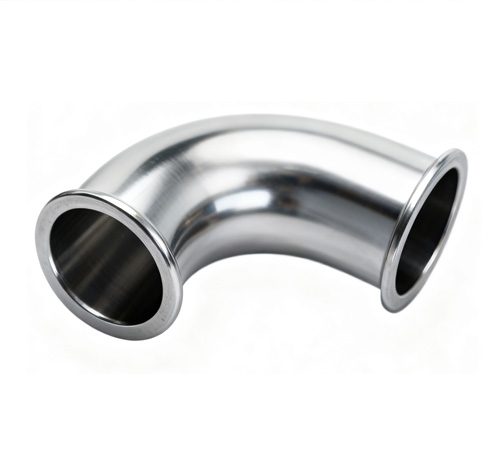- Whatsapp: 8613738300923
- Email: [email protected]
When it comes to piping systems, whether in plumbing, industrial plants, or construction, one of the most essential fittings you will encounter is the 90 degree elbow. This simple yet crucial component allows pipelines to change direction smoothly and efficiently. In this blog, we will explore what is 90 degree elbow , its types, materials, properties, uses, and why it is indispensable in piping and fluid transport systems.
90 degree elbow is a pipe fitting that allows pipes to make a precise right-angle bend, changing the direction of the pipe and achieving a 90-degree turn.
The stainless steel 90 degree elbow can be used in many piping systems, including water supply, oil and gas, chemical plants, HVAC, and more.
There are primarily two categories of stainless steel Elbow 90 degree based on their curvature radius:
| Type | Radius of Curvature | Flow Characteristics | Typical Use |
| Long Radius (LR) Elbow | 1.5 times the pipe size | Smoother flow, less turbulence | Used when space allows, industrial applications like pumps and valves |
| Short Radius (SR) Elbow | Equal to pipe size | More turbulence, higher flow resistance | Used in tight spaces where compact piping is needed |
The radius of curvature is 1.5 times the nominal pipe size (NPS).
It provides a smoother flow path, reducing turbulence and pressure loss.
Commonly used where there is enough space for installation and flow efficiency is important.
Suitable for many industrial applications like pumps, valves, and drains.

The radius of curvature is equal to the nominal pipe size (NPS).
Used in confined spaces where compact piping is necessary.
While saving space, it creates higher flow resistance and turbulence compared to long radius elbows.
| Material | Common Uses |
| Carbon Steel | Low to medium temperature, non-corrosive gases |
| Stainless Steel | Corrosive environments, high temperature, food-grade |
| Brass & Copper | Residential plumbing, HVAC systems |
| PVC & CPVC | Drainage, water supply, low-pressure, chemical resistance |
| Cast Iron, Bronze, Galvanized Steel, Aluminum, Rubber | Various specific industry needs |
90 degree elbows are manufactured from various materials depending on their application and operating conditions:
Carbon Steel: Common for low to medium temperature applications and non-corrosive gases.
Stainless Steel: Ideal for corrosive environments, high temperatures, and food-grade applications.
Brass and Copper: Often used in residential plumbing and HVAC systems.
PVC and CPVC: Widely used in drainage, water supply, and low-pressure applications due to chemical resistance.
Cast Iron, Bronze, Galvanized Steel, Aluminum, and Rubber: Also used depending on the specific needs and industries.
Mechanical Properties:
90 degree elbows provide strength and durability to withstand the pressure and stress of fluid flow. The choice of material affects their resistance to deformation, pressure rating, and longevity.
Chemical Properties:
Depending on the material, these elbows can resist corrosion, chemical attack, and temperature variations. For example, stainless steel elbows resist oxidation and harsh chemicals, making them suitable for chemical plants and marine environments.
Connection Types:
They come with different connection methods including:
Socket weld
Butt weld
Threaded
Soldered or sweat connections
| Application Area | Description |
| Residential & Commercial Plumbing | Change pipe directions in water, drainage, HVAC |
| Industrial Piping | Used in oil, gas, chemical, power plants |
| Tight Spaces | Short radius elbows fit compact areas |
| Marine Applications | Stainless steel elbows resist corrosion |
| Food & Beverage Industry | Stainless steel for hygiene and corrosion resistance |
Residential and Commercial Plumbing: Changing pipe directions in water supply lines, drainage, and HVAC systems.
Industrial Piping: Oil and gas refineries, chemical processing plants, power plants, and petrochemical industries rely heavily on 90 degree elbows to manage flow direction.
Tight Spaces: Short radius elbows are often used where space constraints exist, such as inside machinery or compact piping layouts.
Marine Applications: Stainless steel elbows provide corrosion resistance in marine environments.
Food and Beverage Industry: Stainless steel elbows are used due to their hygienic properties and corrosion resistance.
Selecting the right elbow involves considering:
Material compatibility with the fluid/gas being transported
Space availability for installation
Pressure and temperature ratings of the system
Corrosion resistance needs
Welding or connection method compatible with your piping system
Proper selection ensures durability, minimal leakage, and system efficiency.
A 90 degree elbow is a fundamental pipe fitting that plays a crucial role in redirecting the flow of fluids and gases in piping systems. Its design — either long radius or short radius — and the material from which it is made determine its suitability for specific applications, ranging from household plumbing to heavy industrial uses.
Understanding the properties, types, materials, and applications of 90 degree elbows helps engineers, contractors, and homeowners make informed decisions, ensuring optimal performance, safety, and cost-efficiency in their piping projects.
Privacy Policy | SiteMap
Copyright GENCEL STAINLESS STEEL CO.,LIMITED